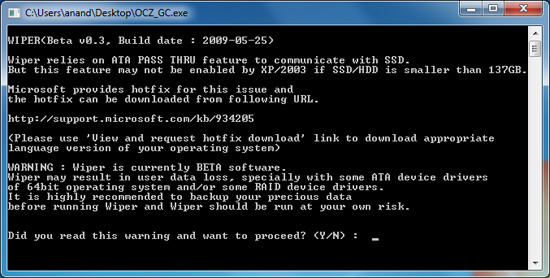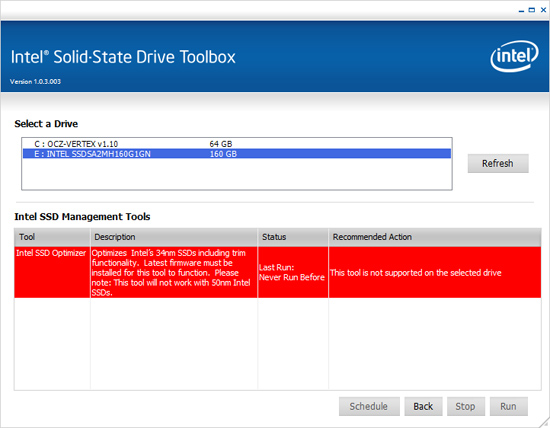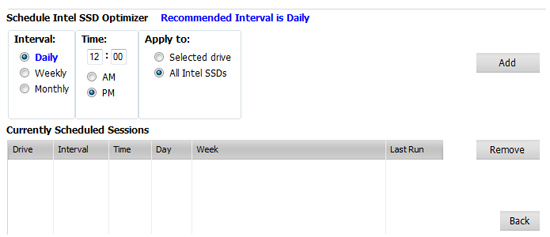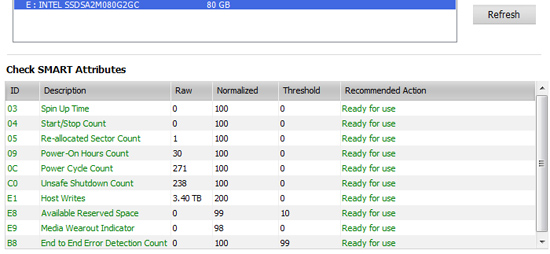The SSD Improv: Intel & Indilinx get TRIM, Kingston Brings Intel Down to $115
by Anand Lal Shimpi on November 17, 2009 7:00 PM EST- Posted in
- Storage
Wipe When You Can’t TRIM
There’s a major problem with TRIM today. The only Windows storage drivers to support it are written by Microsoft. The Intel Matrix Storage Manager (IMSM) driver will not pass the TRIM instruction to your SSD. This means you can't use anything but the drivers that ship with Windows 7. To make matters worse, if you enable non-member RAID on an Intel motherboard the default Windows 7 driver is an older version of IMSM so TRIM won't work there either - even if you don't have a RAID array created. Your best bet is to install Windows 7 with your I/O controller in AHCI mode (for Intel chipsets) and don't install any storage drivers. Intel is working on an updated IMSM that will pass the TRIM instruction to SSDs but it won't be ready for at least a couple of months.
TRIM won't work on a RAID array.
If you want to use IMSM or if you're using Windows XP or Vista, both of which do not support TRIM, there's another option. Earlier this year Indilinx released its Wiper Tool that performs a manual TRIM on their SSDs. It works by asking the OS for a list of the free space addresses on the partition and then sending the list with instructions to TRIM down to the SSD.

The Indilinx Wiper Tool
Today Intel introduces its own manual TRIM tool as a part of the SSD Toolbox:

On any Windows OS (XP, Vista or 7) regardless of what driver you have installed, Intel's SSD Toolbox will allow you to manually TRIM your drive. Intel calls it the SSD Optimizer, which of course only works on 34nm Intel SSDs (X25-M G1 owners are out of luck unfortunately).

The Intel SSD Optimizer lets you schedule the manual TRIM operation automatically
The SSD Toolbox also gives you access to SMART and drive health data, including telling you how many writes you've performed on your SSD, and what your current flash wear level is:

Running Intel's SSD Optimizer does work as advertised. I ran the PCMark HDD suite on a clean X25-M, once more on a drive that had been well used and once more after running the SSD Optimizer:
| PCMark Vantage HDD Score | Clean Run | Used Run | After SSD Optimizer |
| Intel X25-M G2 160GB | 35909 | 30354 | 34014 |
Intel's SSD Optimizer should be able to restore performance to about 95%+ of new, in this case it manages 94.7% - close enough.
Moving On: Forget About Invalid Data and Worry About Free Space
The existence of TRIM changes the way we test, something I alluded to in the SSD Relapse. Thankfully, we come prepared.
In previous articles we had to test SSDs in two conditions: new and used. The new state is just after a secure erase, the used state required us to write data to every user accessible portion of the drive first before benchmarking. The former resulted in great performance, the latter meant the SSD had to do a lot of juggling of existing data whenever it went to write. The second scenario no longer exists with TRIM. The act of formatting your drive or deleting files (and emptying the recycle bin) will TRIM invalid data.
Performance in a TRIM enabled system is now determined not by the number of invalid blocks on your SSD, but rather the amount of free space you have. I went into a deep explanation of the relationship between free space and the performance of some SSDs here.
TRIM will make sure that you don’t have to worry about your drive filling up with invalid data, but it doesn’t skirt the bigger issue: dynamic controllers see their performance improve with more free space.
My rule of thumb is to keep at least 20% free space on your drive, you can get by with less but performance tends to suffer. It doesn’t degrade by the same amount for all drives either. Some controllers are more opportunistic with free space (e.g. Intel), while others don’t seem to rely as much on free space for improved performance. Addressing performance degradation as drives fill up (with valid data) will be one of the next major advancements in SSD technology.










162 Comments
View All Comments
Anand Lal Shimpi - Monday, October 26, 2009 - link
Personally my pick is still the X25-M, it's had a better track record than any of the other controller makers. The problem for Intel is that Indilinx performance and feature set have both gotten a lot better.You now get TRIM, reliable performance, competitive pricing and generally everything but a super dynamic controller that's constantly trying to maximize performance. Depending on the usage scenario though, the latter may not matter as much (see my Photoshop results from the last review or the heavy trace results from this review).
My position hasn't really changed, just highlighting the importance of the issue so that hopefully Intel's value SSDs next year aren't just rebadged G2s :)
Take care,
Anand
7Enigma - Monday, October 26, 2009 - link
I think his previous review is consistent with this one. His ultimate recommendation between Intel and Indlinx drives has remained unchanged. That is, they are close enough that the size differences should be the decider for a potential buyer.As it stands, in most normal usage scenarios the statement from his last article still applies. There are very few times where you are going to be constantly tapping the 80MB/s barrier. More often you will be limited by the other SSD's lower random write speeds.
What his own benchmark can show is that in uncommon circumstances you can sway the bar back towards parity between the brands. I would argue, however, that the "heavy" usage scenario is not a practical one for an SSD. Just read his description again and look for all of the places the average user would NOT be putting that data onto an SSD:
[quote]
In this test we have Microsoft Security Essentials running in the background with real time virus scanning enabled. We also perform a quick scan in the middle of the test. Firefox, Outlook, Excel, Word and Powerpoint are all used the same as they were in the light test. We add Photoshop CS4 to the mix, opening a bunch of 12MP images, editing them, then saving them as highly compressed JPGs for web publishing. Windows 7’s picture viewer is used to view a bunch of pictures on the hard drive. We use 7-zip to create and extract .7z archives. Downloading is also prominently featured in our heavy test; we download large files from the Internet during portions of the benchmark, as well as use uTorrent to grab a couple of torrents. Some of the applications in use are installed during the benchmark, Windows updates are also installed. Towards the end of the test we launch World of Warcraft, play for a few minutes, then delete the folder. This test also takes into account all of the disk accesses that happen while the OS is booting.
The benchmark is 22 minutes long and it consists of 128,895 read operations and 72,411 write operations.
[quote]
How many people are going to be opening photoshop pictures FROM the SSD and saving them TO the SSD? Same goes with Windows Picture Viewer. Most people will have their pics on a standard large mechanical HD which makes this a moot point. Downloading large files from the net? Not a chance that would be going to my SSD! Bottom line is this is a great HELL test, but nowhere close to real-world usage.
The light-usage probably fits 90% of people 90% of the time (completely made up statistic).
With all of that said, I wish Intel's 80gig drive had closer sequencial write performance as the Indilinx drives, as it would make the decision a complete no-brainer. Looking at all the data, and planning on buying a ~$250 drive this holiday season has me very likely picking up an 80gig Intel as for me the price is about as steep as I'm willing to go for essentially a boot drive, with performance that for the majority of the time is at the top of the pack. It would be WAYYYY more difficult to decide if both Intel/Indilinx had the same drive sizes but fortunately we don't have to worry about that (at least for now....)
tynopik - Monday, October 26, 2009 - link
on page 7, all the graphs have two lines labelled 'Intel X25-M G2 80GB (MLC) TRIM'7Enigma - Monday, October 26, 2009 - link
Anand,You have listed the 80gig Intel MLC drive twice in each chart. I'm assuming one of them shouldn't say (TRIM)?
Other than that, GREAT article! Those Kingston drives look to be the PERFECT inexpensive replacement for netbooks/cheaper laptops as the performance is vastly superior to cheap mechanical HD's.
Anand Lal Shimpi - Monday, October 26, 2009 - link
That second 80GB MLC drive was actually a second set of results that didn't get pulled out. I've trimmed em out :)Take care,
Anand
fic2 - Monday, October 26, 2009 - link
"The G1 is more resillient (SIC) than the G2 when it comes to performance degradation over time since it doesn't have TRIM."Is it just me or does this sentence make no sense? I thought the whole purpose of TRIM was to make the SSD more resilient to performance degradation. Seems like it should be:
"The G1 is less resilient..."
klil - Monday, October 26, 2009 - link
The G1 is LESS susceptible to degradation than the G2, Intel compensates this by enabling TRIM on the G2.Anand Lal Shimpi - Monday, October 26, 2009 - link
Correct, my apologies for the confusing wording :)Take care,
Anand
edzieba - Monday, October 26, 2009 - link
"None of the other Indilinx manufacturers have Windows 7 TRIM support yet."Crucial has the TRIM firmware (1819) available for download for their m225 series SSDs.
TheWickerMan - Monday, October 26, 2009 - link
I was just going to post that, but you beat me to it. Here's the link for anyone else interested: http://www.crucial.com/support/firmware.aspx">http://www.crucial.com/support/firmware.aspx